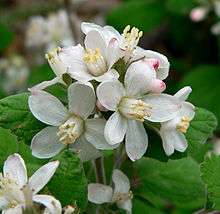Jamesia
| Jamesia | |
|---|---|
 | |
| Scientific classification | |
| Kingdom: | Plantae |
| (unranked): | Angiosperms |
| (unranked): | Eudicots |
| (unranked): | Asterids |
| Order: | Cornales |
| Family: | Hydrangeaceae |
| Genus: | Jamesia |
| Species: | J. americana |
| Binomial name | |
| Jamesia americana Torr. & A.Gray | |
Jamesia is a genus of shrubs in the Hydrangeaceae, most commonly known as Jamesia, cliffbush or waxflower. It is native to interior western North America, in the U.S. states of Arizona, California, Colorado, Nevada, New Mexico, Utah, and Wyoming, growing in mountains at 1600–3000 m altitude.
There is just one species, Jamesia americana, though some botanists treat it as two species, the second being J. tetrapetala (fourpetal cliffbush, with the narrow sense J. americana then known as fivepetal cliffbush).
It is a shrub growing to 1–2 m tall and to 3 m or more broad, with opposite simple leaves 3–7 cm long and 2–5 cm broad, with a serrated margin and a crinkled surface. The flowers are produced in erect terminal panicles, each flower white, 15–20 mm diameter, with five (rarely four) petals. The fruit is a dry capsule with numerous small seeds.
The genus is named for Edwin James, the botanist for Stephen Long's expedition that explored the territory between the Platte and Arkansas Rivers in 1820. James was the first to collect this genus for botanical study.
External links
| Wikimedia Commons has media related to Jamesia. |